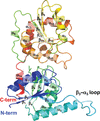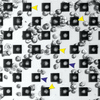issue contents
July 2021 issue

scientific commentaries
BIOLOGY | MEDICINE
Insights are offered on the study by Kelpšas et al. [IUCrJ (2021). 8, 633–643], who have combined neutron and X-ray crystallography then QM (quantum mechanics) calculations on triosephosphate isomerase (TIM). The authors dissect three possible enzyme mechanisms of TIM that have arisen in the decades since the first X-ray crystal structure of this enzyme was published in 1975.
PHYSICS | FELS
SFX diffraction data collection at XFELs is becoming more accessible. To extract the most useful biological information from these non-standard experiments, standards for SFX data analysis and structure validation must be redefined.
lead articles
CHEMISTRY | CRYSTENG
A comprehensive review of hybrid lead halide perovskites based on [PbX4]∞ layers is presented. We use a crystallographic approach based on symmetry mode analysis to systematize key types of distortions, particularly octahedral tilting and layer shifts, in this extensive and diverse family of materials.
feature articles
BIOLOGY | MEDICINE
The structural and biophysical aspects of a diversified group of enzymes that hydrolyze L-asparagine are reviewed in the context of their mechanism and biological function, and as therapeutic agents for the treatment of leukemia.
PHYSICS | FELS
Serial femtosecond crystallography is coming of age. Therefore, it is time to consider best practices and appropriate standards.
research letters
BIOLOGY | MEDICINE
Non-rotationally averaged 3D structures of fibers can be restored from their rotationally averaged diffraction patterns.
research papers
BIOLOGY | MEDICINE
Crystal structures of Rib2 deaminase reveal its substrate specificity and catalytic mechanism.
MATERIALS | COMPUTATION
The present laboratory diffraction contrast tomography suffers from poor spatial resolution – only grains larger than 40 µm can be reliably imaged. In this work, it is shown how this serious limitation can be lifted and the spatial resolution improved significantly.
BIOLOGY | MEDICINE
The glycosyltransferase MurG from the human pathogen A. baumannii was characterized and its hexameric crystal structure was unveiled. This is the first homo-oligomeric structure to be described in the MurG family and the Mur family. The homo-oligomerization mechanism of MurG is clarified, thus opening the door for the design of next-generation antibiotics that target MurG.
PDB reference: MurG, 7d1i
CHEMISTRY | CRYSTENG
Ubiquitous defects in polycrystalline powders and single crystals affect the pathways of polymorphic solid-to-solid phase transitions. Dependent on the density of crystal defects, the phase transition mechanism can be dominated by either the cooperative molecular motion pathway or the nucleation and growth pathway.
CHEMISTRY | CRYSTENG
A complete set of new methods have been proposed that can determine lamellar thickness, long period and lateral size of lamellar crystals readily and accurately.
MATERIALS | COMPUTATION
Download citation


Download citation


A series of Hirshfeld atom refinements (HARs) has been performed for an organo-gold(I) compound at different levels of theory. The influences of the relativistic effect, electron correlation and anharmonic thermal motion have been studied based on aspherical charge density models obtained with HAR.
NEUTRON | SYNCHROTRON
Decellularized pericardium tissue exposed to solutions of sugars like glucose, galactose and ribose could potentially be a model system for diseases like diabetes and the effects of aging. Scanning X-ray diffraction and scattering reveals the different nano-structural changes of collagen induced by glucose, galactose and ribose.
BIOLOGY | MEDICINE
The high-resolution neutron structure of triosephosphate isomerase was determined in complex with two inhibitors that mimic intermediate states in the reaction mechanism. This shows clear protonation states of the catalytic residues, which allow a computational investigation of the disputed reaction mechanism.
CHEMISTRY | CRYSTENG
Download citation


Download citation


The procedure for study of charge density at high pressures and/or high temperatures by the transferrable aspherical atom model (TAAM) is described and discussed. The experimental charge densities were verified and corroborated by periodic DFT computation. This method was tested on a salt of 5,6-dichloro-2,3-dicyanosemiquinone radical anion which comprises two-electron multicentre bonding between the radicals.
CHEMISTRY | CRYSTENG
The mechanism of a solid–solid phase transition in an RNA crystal is presented.
BIOLOGY | MEDICINE
A rapid fixed-target method is described for serial femtosecond crystallography diffraction data collection using in cellulo grown protein crystals directly within living insect cells.
BIOLOGY | MEDICINE
C-C chemokine receptor 5 (CCR5) is a major co-receptor molecule used by HIV-1 to enter cells. Two X-ray crystallographic studies are presented of the antibody RoAb13, which binds to the peptide PIYDIN, which is part of the N-terminal domain of CCR5. The results may provide the basis for active immunization vaccines to stimulate an antibody response to native CCR5 that will block HIV infection.
BIOLOGY | MEDICINE
The crystal structure of CYP105D18 and its unique structural features for papaverine N-oxidation are presented.
MATERIALS | COMPUTATION
Distinct `hidden' phases of a technologically relevant thermoelectric material, which are identical in terms of composition and periodic crystal structure, but differ on a local scale, are observed and can be controlled through synthesis conditions. The local structure is explained in terms of a vacancy repulsion model, and relaxations around vacancies are characterized.



 journal menu
journal menu




 access
access

































